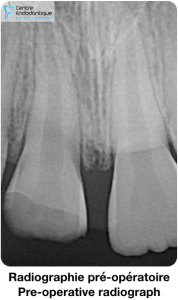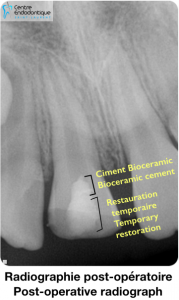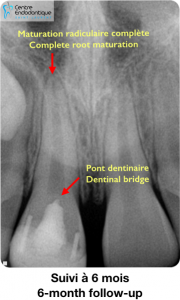A case study by Dr. Chafic Safi, Centre Endodontique St-Laurent
An 11 year-old caucasian female presented to our office on a cold winter day in December after slipping on ice and breaking her front tooth.
Analysis
Clinical exam revealed an enamel and dentin fracture with subsequent pulp exposure of tooth #11. The neighbouring teeth did not present any signs of trauma.
The patient was asymptomatic at time of examination, and there was no history of spontaneous pain or swelling, thus eliminating the possibility of pulpal necrosis. A head and neck exam was also performed to rule out any possible broken bones or trauma sequela.
Radiological exam revealed that tooth #11 had a broken crown and an immature (open) apex.
Diagnosis
The diagnosis was: Asymptomatic irreversible pulpitis and normal apical tissues.
Treatment
The treatment options offered to the patient were:
- Apexogenesis via partial or full pulpotomy. Prognosis: Favorable
- Apexification with a Bioceramic plug. Prognosis: Favorable
Treatment Selection
The parents consented for apexogenesis.
The treatment
The procedure was completed in 1 visit. Using rigorous aseptic techniques, a full pulpotomy was performed with placement of Bioceramic Root Repair Material, a calcium silicate cement, on the remaining pulpal tissue and sealing the tooth with a temporary filling. The decision to do a full pulpotomy was taken to better control the bleeding.
The patient was then referred to her restorative dentist for the permanent restoration.
Follow-up
A 6-month follow-up showed absence of any signs or symptoms.
The radiograph shows complete root maturation and formation of dentinal bridge, hence isolating and protecting the pulpal tissue.
More Information
Key points to remember when performing a partial or full pulpotomy:
- There should be no signs or symptoms suggestive of pulpal necrosis
- Avoid using hemostatic agents in order to conserve the vitality of the remaining pulpal tissue
- Sealing the root canal space with a calcium silicate cement is imperative
- Failures will mostly occur due to a poor coronal restoration


